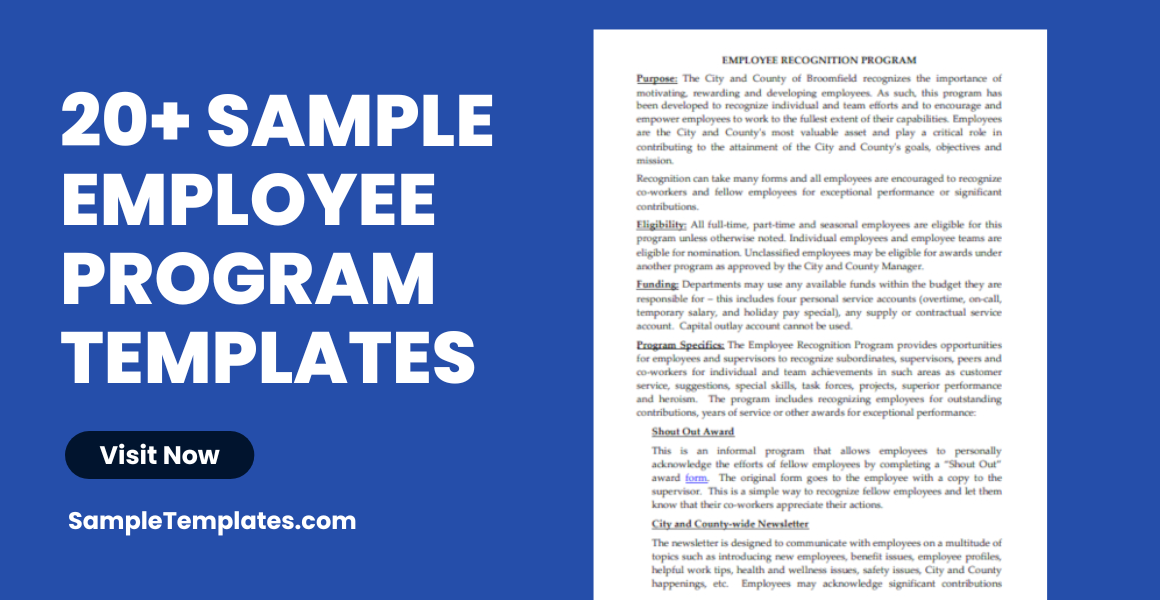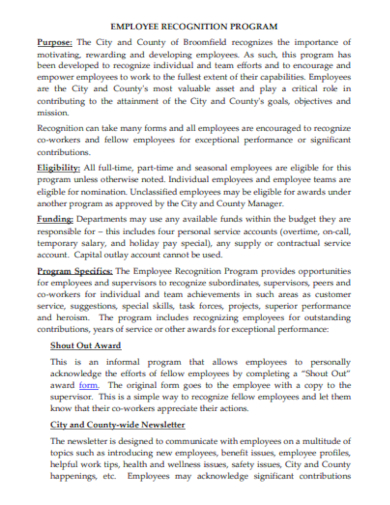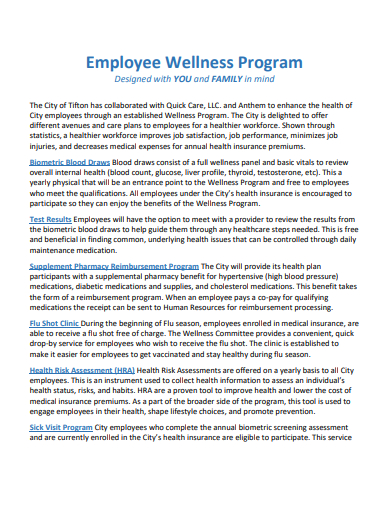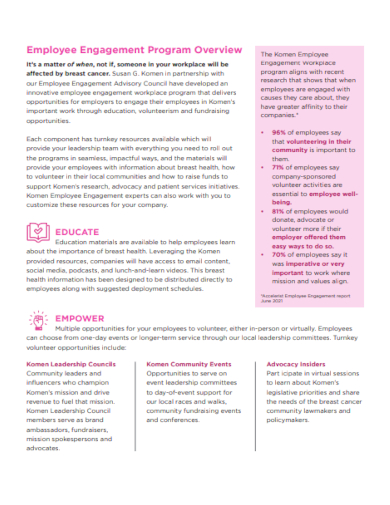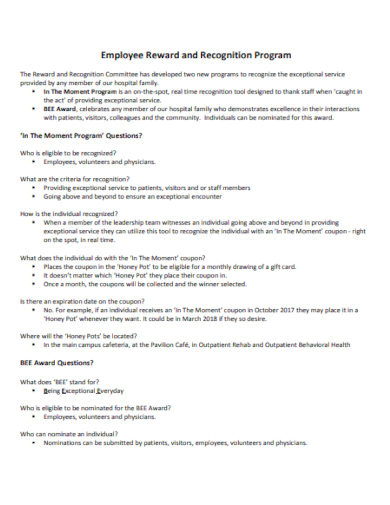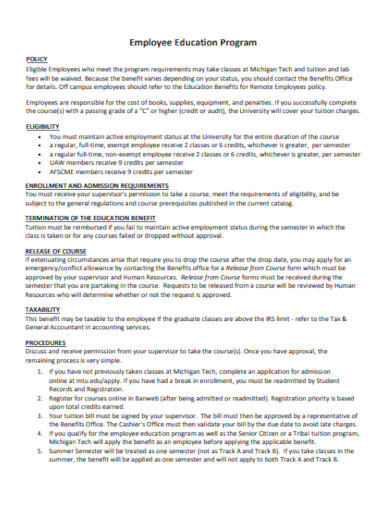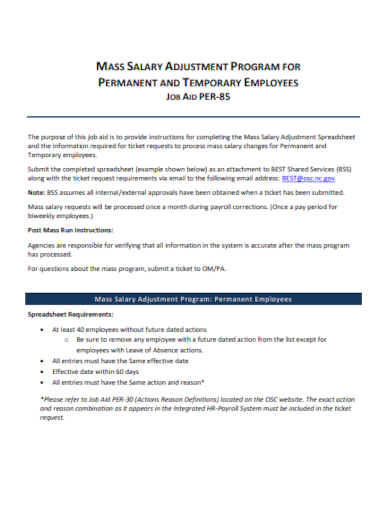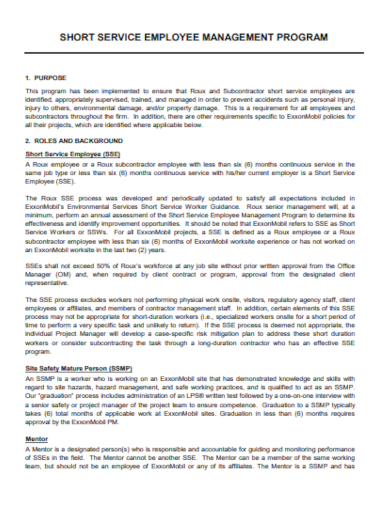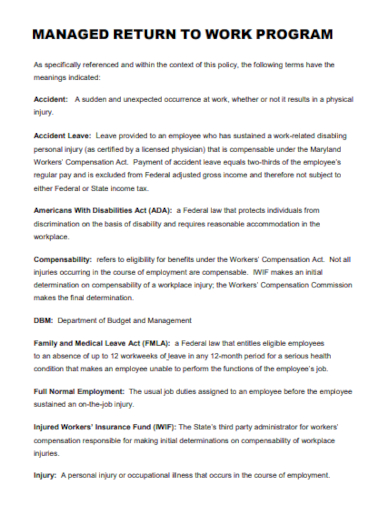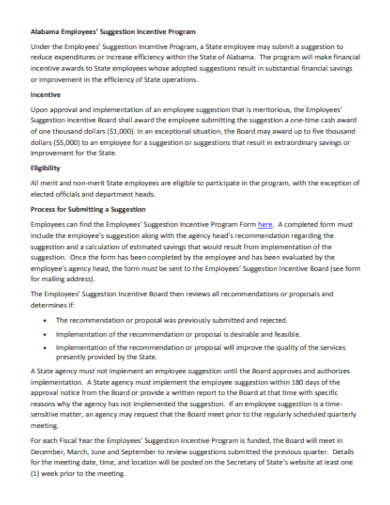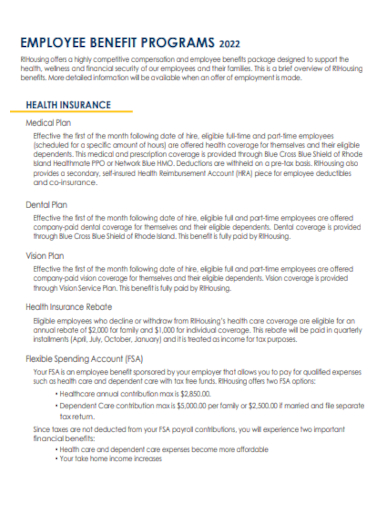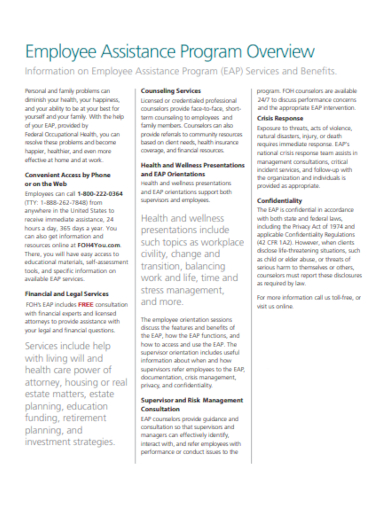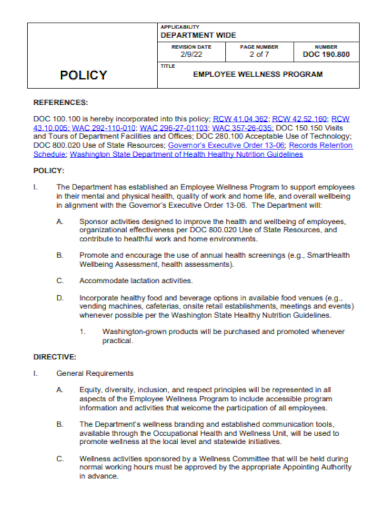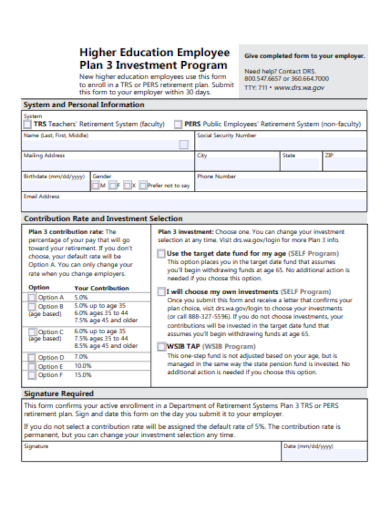Introducing our Employee Program Template, complete with a dynamic Training Plan to drive organizational excellence. This all-encompassing resource equips your company with the tools needed to cultivate a motivated and engaged workforce. From optimizing your onboarding procedures to executing ongoing professional development strategies, our template serves as your comprehensive guide. Streamline HR processes, nurture a positive workplace culture, and bolster employee retention rates with this invaluable Training Plan at the core. Let’s embark together on the path to creating a thriving workplace!
20+ Employee Program Samples
1. Employee Referral Program Sample Email Template
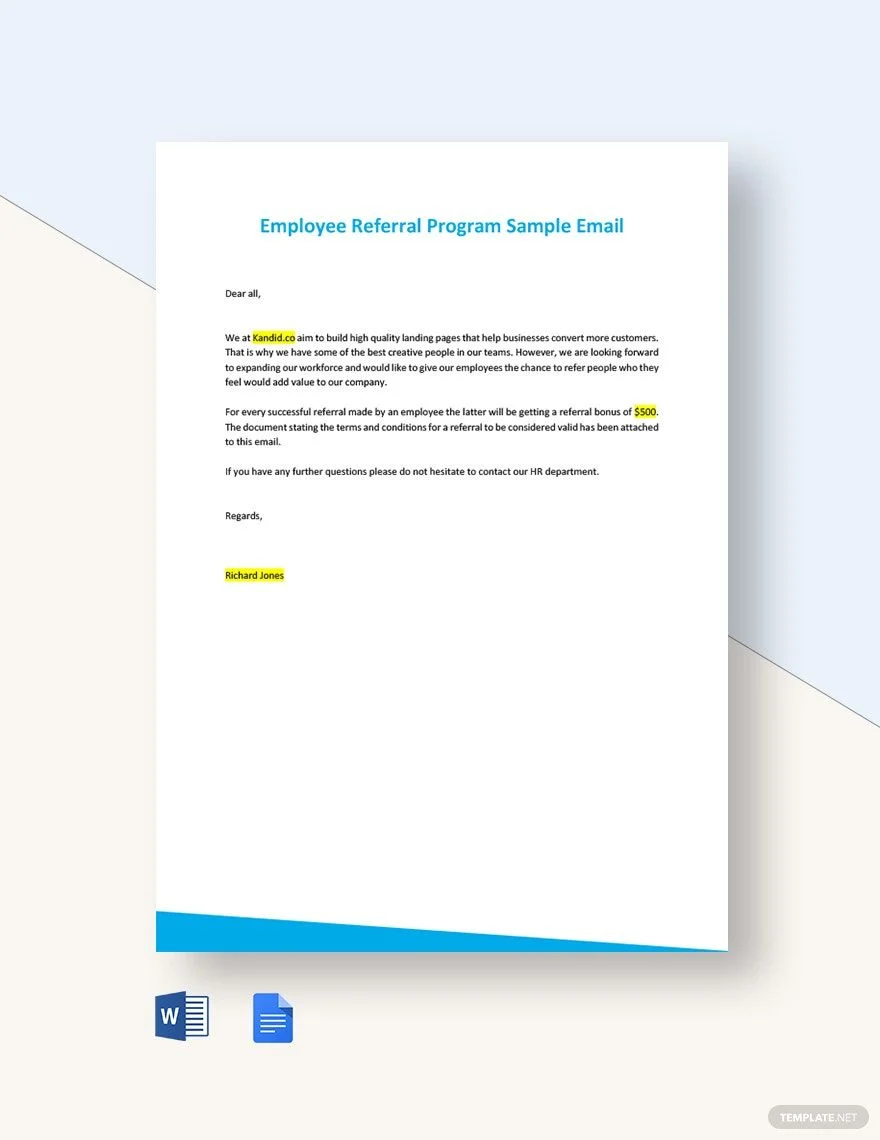
2. Employee Volunteer Program Roadmap Template
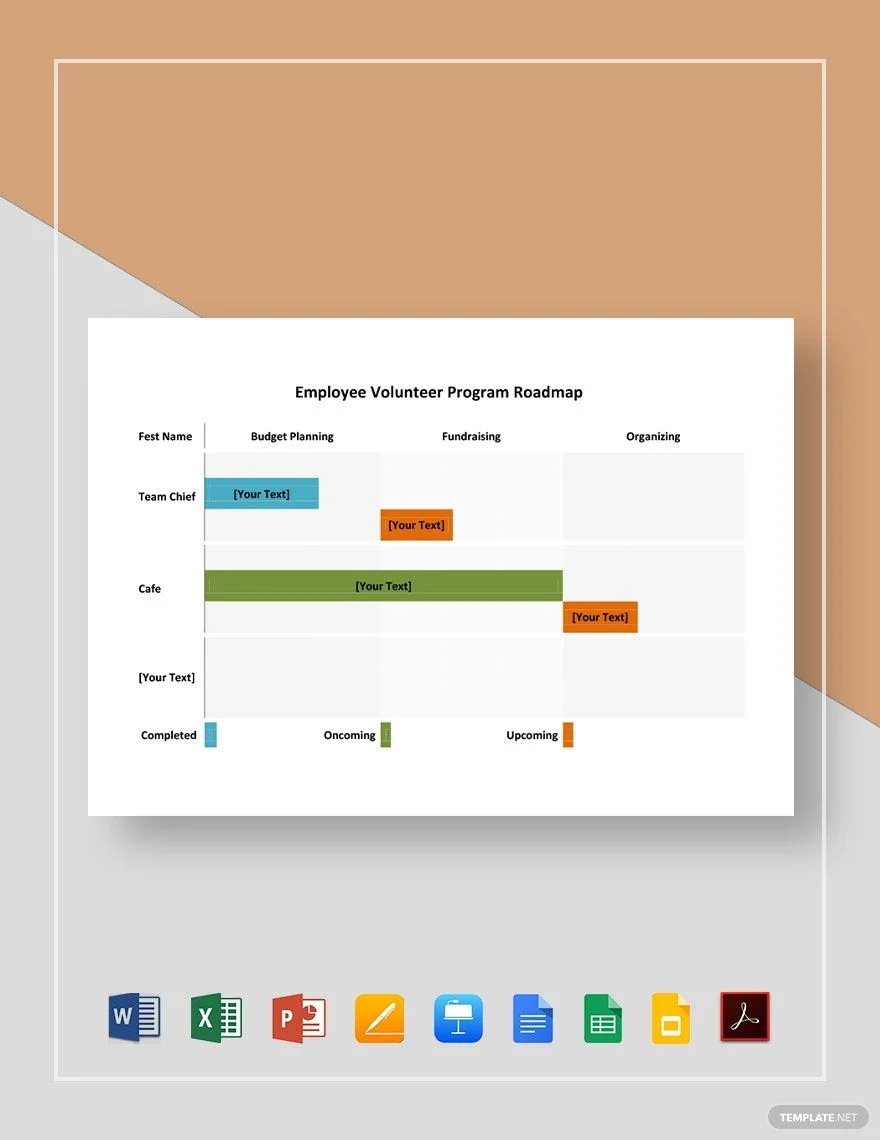
3. Employee Assistance Program Outline Template
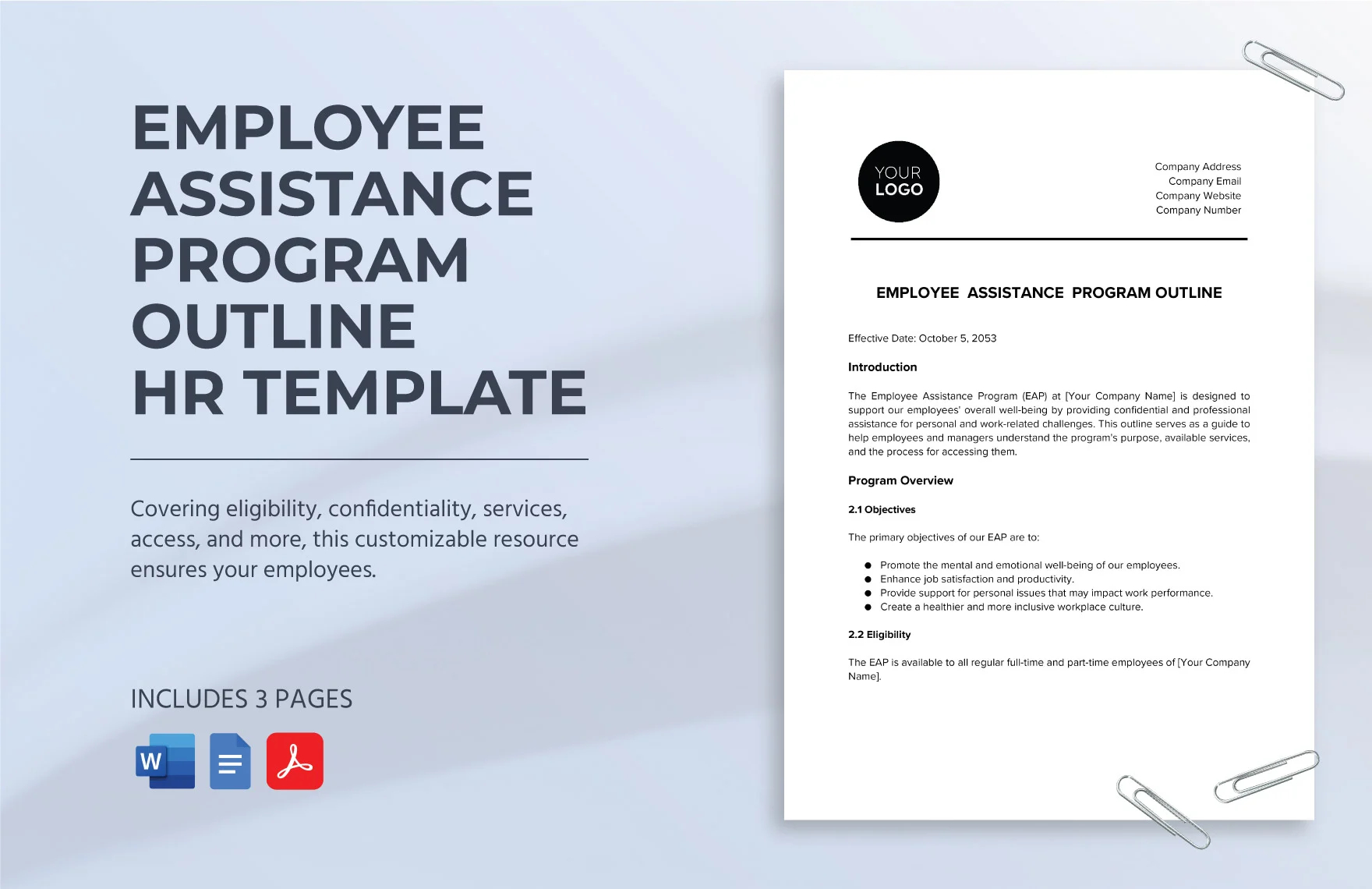
4. Employee Recognition Program
5. Employee Training Program
Why do you need a training program?
A well-structured and effective training program sample is a cornerstone of success for individuals, teams, and organizations across various industries and sectors. Whether you’re a small business owner, a manager, or an employee, understanding the importance of a training program is vital for personal and professional growth, as well as for achieving broader business objectives.
Skill Development: One of the primary reasons for having a training program is skill development. In a rapidly changing world, skills can quickly become outdated. By implementing a training program, individuals and organizations can stay current with the latest industry trends and technologies. This ensures that employees are equipped with the skills necessary to perform their tasks efficiently and effectively.
Increased Productivity: Training programs are designed to enhance an individual’s ability to perform their job analysis. When employees are well-trained, they can complete tasks more quickly and accurately. This leads to increased productivity, which, in turn, benefits the organization’s bottom line. It also reduces the likelihood of errors and the need for constant supervision.
Employee Satisfaction: Investing in training programs demonstrates a commitment to employees’ professional development. This can boost morale and job satisfaction, making employees feel valued and appreciated. Satisfied employees are more likely to stay with an organization, reducing turnover and associated recruitment and training costs.
Adaptation to Change: Industries are constantly evolving, and businesses need to adapt to stay competitive. A training program can help employees and organizations adapt to changes in technology, market trends, regulations, and customer preferences. This adaptability is crucial for long-term success and sustainability.
Consistency: Training programs ensure that employees across different departments or locations receive consistent information and training. This consistency is particularly important in industries where compliance, safety, or quality standards must be maintained. It helps ensure that everyone is on the same page, reducing the risk of errors or inconsistencies.
Innovation: Training programs can foster a culture of innovation within an organization. When employees are encouraged to learn and explore new ideas, they are more likely to come up with creative solutions to problems and contribute to the company’s growth and competitiveness.
Risk Reduction: Proper training can mitigate risks associated with safety, compliance, and legal matters. In industries such as healthcare, manufacturing, and finance, the consequences of errors can be severe. A well-designed training program can help reduce the likelihood of costly mistakes.
Career Progression: For individuals, a training program is often a pathway to career advancement. It can provide the skills and knowledge necessary to take on more challenging roles within an organization, leading to personal growth and increased earning potential.
Competitive Advantage: In today’s competitive business landscape, having a highly skilled and adaptable workforce can be a significant competitive advantage. Customers and clients are more likely to choose organizations that demonstrate a commitment to quality and expertise.
A training program is not just a luxury but a necessity in today’s fast-paced and dynamic world. It is an investment in people and an organization’s future success. Whether it’s enhancing skills, increasing productivity, or adapting to change, the benefits of a well-implemented training program are manifold and can contribute significantly to personal and organizational growth.
6. Employee Wellness Program
7. Employee Engagement Program
8. Employee Reward Program
9. Employee Education Program
10. New Employee Program
11. Employee Salary Program
12. Employee Management Program
13. Employee Return to Work Program
14. Employee Incentive Program
How do you create an employee program?
Creating an effective employee program is a strategic process that involves careful planning, clear objectives, and a commitment to ongoing improvement. Here are the key steps to create an employee program:
Define Your Objectives:
Start by identifying the specific goals and objectives you want to achieve with your employee program. These could include improving employee performance, enhancing job satisfaction, increasing retention rates, or developing leadership skills.
Assess Your Needs:
Conduct a thorough assessment of your organization’s needs and challenges. This may involve surveys, interviews, and data analysis to understand where improvements are needed.
Budget and Resources:
Determine the sample budget and resources available for your employee program. Consider factors such as training materials, technology, trainers or facilitators, and any external resources you might need.
Program Design:
Develop a program structure and curriculum that aligns with your objectives. Consider the types of training or development activities that will best meet your goals, such as workshops, online courses, mentoring, or on-the-job training.
Content Development:
Create or source content for your program. This could include developing training materials, videos, presentations, or hiring subject matter experts to create content.
Delivery Method:
Determine how you will deliver the program content. Options include in-person training, virtual training, e-learning platforms, or a combination of these methods. Choose the delivery method that best suits your organization’s needs and resources.
Feedback Mechanism:
Implement a feedback mechanism to gather input from employees who participate in the program. This sample feedback can help you make necessary adjustments and improvements to the program.
Engagement and Participation:
Promote the program within your organization to encourage participation. Clearly communicate the benefits of the program to employees and create incentives, if necessary, to boost engagement.
Training and Development Plans:
Create individualized training and development plans for employees based on their specific needs and career goals. These plans should align with the overall program objectives.
Implementation:
Launch the program and ensure that all necessary resources, including trainers or facilitators, technology, and materials, are in place. Monitor the program’s progress closely during this phase.
Measurement and Evaluation:
Continuously assess the program’s effectiveness by measuring key performance indicators (KPIs) related to your objectives. Collect data on employee performance, satisfaction, and any changes in behavior or skills.
Adjust and Improve:
Use the data and feedback collected to make necessary adjustments and improvements to the program. This may involve updating content, modifying delivery methods, or addressing specific issues raised by participants.
Ongoing Support:
Provide ongoing support and resources to employees who have completed the program to ensure they continue to apply their new skills and knowledge in their roles.
Celebrate Success:
Recognize and celebrate the achievements of employees who have benefited from the program. This can motivate others to participate and succeed as well.
Communication and Transparency:
Maintain open communication with employees about the program’s progress, outcomes, and future plan sample. Transparency can build trust and engagement.
Creating an employee program is an ongoing process that requires dedication and a commitment to continuous improvement. By following these steps and regularly evaluating the program’s impact, you can develop a program that not only meets your organization’s objectives but also contributes to the growth and development of your employees.
15. Employee Benefit Program
16. Employee Services Program
17. Employee Career Enhance Program
18. Employee Wellness Program Policy
19. Employee Referral Program Fact Sheet
20. Employee Assistant Program
21. Employee Plan Investment Program
What should an employee program include?
An employee program should encompass a holistic approach to support the development, engagement, and well-being of the workforce. It starts with a well-structured onboarding process to familiarize new hires with the organization’s culture, policies, and their roles.
Training and development initiatives are crucial for enhancing employees’ skills and knowledge, ensuring they are equipped to excel in their positions and grow within the company. Pairing experienced employees with newcomers through mentorship and coaching programs fosters knowledge transfer and skill development.
Effective performance management involves regular feedback, goal-setting, and performance appraisals, helping employees stay motivated and aligned with organizational objectives. A competitive benefits package, including healthcare, retirement plans, and paid time off, promotes employee well-being and job satisfaction.
Balancing work and life is vital, and programs supporting this balance, such as flexible work arrangements and stress management resources, contribute to a healthier workplace. Wellness programs encourage physical and mental well-being, promoting overall health and job satisfaction.
Diversity and inclusion initiatives ensure that the workplace is welcoming to all, including diversity training and support networks. Safety and health measures maintain a secure working environment, while employee engagement activities, like team-building events and recognition programs, boost morale.
Supporting career development and growth is key, offering clear paths for advancement and opportunities for skill-building. Effective communication channels keep employees informed, and community involvement programs promote a sense of purpose and social responsibility.
Conflict resolution policies and ethical compliance training contribute to a harmonious workplace, while employee assistance programs provide confidential support for personal and work-related issues. Recognizing and rewarding employee contributions, whether through bonuses or awards, further motivates the workforce.
Continuous improvement mechanisms, informed by employee feedback, ensure that the program remains adaptive and responsive to changing needs. Providing access to necessary technology and tools helps employees perform their roles effectively.
Lastly, clear exit procedures, including exit interviews, support employees who depart, gathering valuable feedback for further program enhancements. An effective employee program thus serves as a multifaceted approach to nurturing a productive, engaged, and satisfied workforce.
Onboarding and Orientation:
A successful employee program begins with a well-structured onboarding process. This includes orientation sessions to introduce new hires to the organization’s culture, policies, and their roles within the company.
Training and Development:
Continuous learning and development are central to employee growth. The program should offer a range of training opportunities, including job-specific and soft skills training, to enhance employees’ capabilities and knowledge.
Support and Well-being:
An employee program should prioritize the well-being of its workforce. This includes initiatives such as wellness programs, mental health support, and benefits packages that cover healthcare, retirement plans, and paid time off.
Career Growth and Recognition:
Employees should have clear paths for career advancement within the organization. Additionally, recognition and rewards systems should be in place to acknowledge and motivate employees for their contributions to the company’s success.
A comprehensive employee program considers these key elements to foster a positive workplace environment, support individual development, and ensure that employees feel valued and engaged. It is a holistic approach to enhancing the overall employee experience within an organization.
Related Posts
FREE Critical Skills Every Project Manager Should Have [ Communication Skills, Conflict Management]
FREE Crucial Steps to Start a Successful Affiliate Marketing Program
FREE How to Write a Funeral Program Obituary with the Use of Templates [ How to Write, Drafting the Funeral Program Obituary ]
FREE 5 Ways to Create an Successful Affiliate Program for Your Business
FREE Essential Tips to Create an Employee Suggestion Program
FREE Things Every Project Manager Should Know
FREE How to Create a Successful Affiliate Marketing Program [ Initial Steps , Benefits and Advantages ]
FREE Benefits of a Return to Work Program [ With Samples ]
FREE Essential Tips to Create an Event Program [ With Samples ]
FREE How to Develop an Effective Employee Training Program [ With Samples ]
FREE What to Include in Your Wedding Program [ With Samples ]
FREE How to Develop a Program Template [ Uses and Benefits, Simple Steps ]
FREE What Are the Uses of Program Templates [ Purpose, How to Create, Guidelines ]
FREE 5+ Audit Program Templates in MS Word | PDF
FREE 8+ Safety Program Samples in PDF
